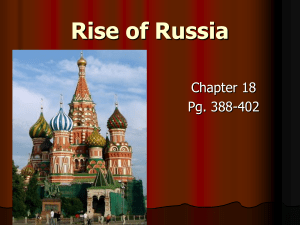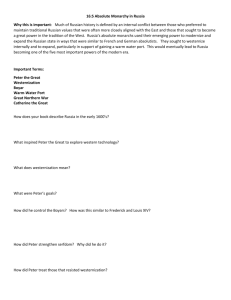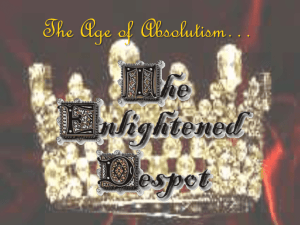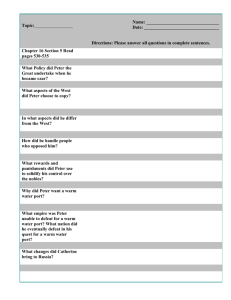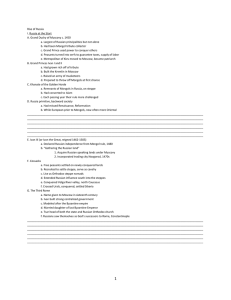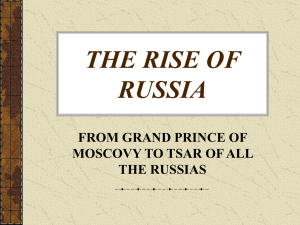Chapter 18 The Rise of Russia
advertisement
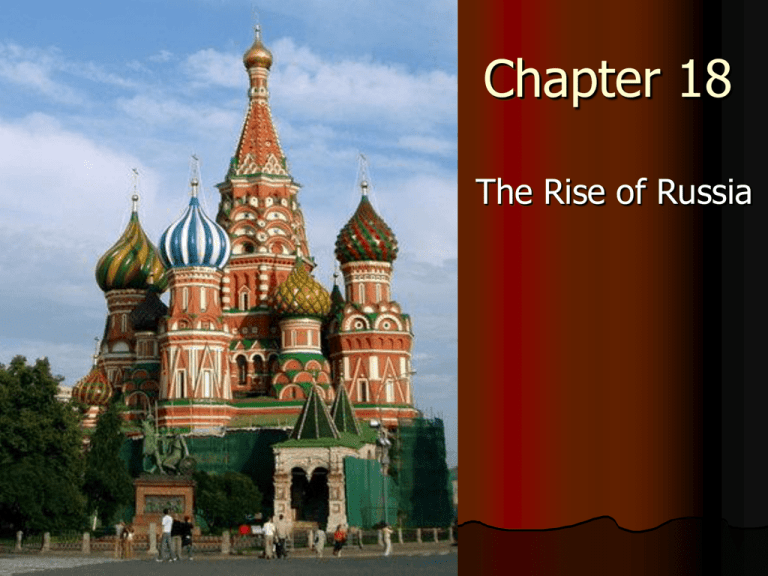
Chapter 18 The Rise of Russia Themes of the Chapter Territorial state huge land empire Power of the tsars & the Romanov Dynasty (1610-1917) Dominant aristocracy Reliance on coercive labor systems Lack of a merchant class Dependence on the West Russia Under the Mongols Late Postclassical period: Mongol conquest & Moscow became center for resistance Result of Mongol Rule = limited cultural development, economic stagnation, dependence on peasant labor Land of the Tsars Video: Rise of Ivan III Ivan IV expansion & attack on boyars Time of Troubles Peter the Great Comparison Use Adan Olearius’s account to compare Western Europe & Russia. Politically Economically Socially Need for Revival & the Ivans Mongol Rule Ivan III (the Great) 1462-1505 Reclaims early Roman, Byzantine Christian traditions Emphasis on military rule Begins an expansionist policy Patterns of Expansion Focused on Central Asia lack of natural barriers made expansion easier Volga River (Astrakhan) became a bustling center for Eurasian trade New trade contacts w/Asia Ottomans, Iran, India Tsars use new lands to reward faithful nobles/bureaucrats Policies toward Native Peoples Siberia is home to 26 ethnic groups Russian gov’t used cossacks & westerners (fur trade) to inhabit the area By 1763, 420,000 Russians live in Siberia Russians wanted tribute in the form of furs & resorted to violence to get it Peter the Great Russia’s 1st Westernization 17th c. = unusually agrarian compared to Europe & Asia So… Peter the Great sought adopting some Western reforms to improve Russian society Peter the Great (1689-1725) Autocrat: Militaristic, suppressed power of nobility, used secret police, used capital punishment Westernization: Political = streamlines bureaucracy Economic= built up mining/ iron industry Social = encourages western styles among the upper classes; education for nobility Peter the Great Read the document: What was his impact? How was he viewed? What a person says is impacted by who they are and where they are This is known as “point of view” in WHAP explaining how the circumstances and background of the author affect a document Some things that impact pov Political ideology, Class, Race, Religion, Nationality, Profession, Gender Not simply bias – everyone is biased Analyze the point of view of Sherbatov’s or Lomonosov’s document. “_________(author) emphasizes _________(content) because ________(circumstance).” “_________(author) attempts to persuade _________(content) because ________(circumstance).” “_________(author) attempts to justify _________(content) because ________(circumstance).” Results of Peter’s Reforms Changes were selective Military & trained bureaucrats, but not representative parliaments or independent merchants Upper class, but not lower class Serf labor expanded Encouraged the autocratic state; didn’t challenge it Widespread resentment as people clung to Russian traditions Catherine the Great (1762-1796) Consolidating Reforms Selective Westernizer Enlightened Despot ? Enlightenment ideals Expands tsarist power Catherine the Great (1762-1796) Political = Economic = further entrenches Russia into serfdom Territorial= increases power of nobility over the serfs, censors revolutionary ideas, crushes rebellions campaigns against the Ottoman Empire, claims Siberia and Alaska, claims part of Poland Cultural = patronized Western art, architecture and clothing styles, but avoided other influences (French Revolution) Selective Westernization: palace architecture Peter I v. Catherine II Who had the greater impact on : Russian politics The Russian economy & serfdom Russian culture Peter Ambitious, Adventurous, Autocratic Related to Caesars, Muscovites, & the Romanovs Lover of sailing, shaving, & ballet Who feels enlightened, armed, & self-conscious Who needs secret police, metallurgy, & serf labor Who fears stagnation, revolt, & boyar influence Who gives codified laws, trained bureaucrats, & new taxes Who would like to see scientific institutes, selective westernization & a warm water port Resident of 18th century, St. Petersburg, Russia the Great Russia Today: Czar Putin? CNN’s Amanpour Reports: Czar Putin Trade & Economic Dependence 95% rural population; few artisans or merchants Little incentive for agricultural or industrial innovation Vast size allows economy to support nobility & growing population Serfdom 1200s: peasants relatively free before Mongols 1500s: serfdom used to appease nobles & extend state control 1649: serfdom became hereditary 1700s: laws tie serfs to land, give nobles great rights Serfs were almost slaves Peasants in Russian village Reflection Write a paragraph in response to one of the following: 1. Compare and contrast Russia (3rd Rome) to the Roman Empire 2. Compare and contrast Peter the Great & Catherine the Great. 3. Explain the connections between early modern Russia and 20th century Communist/post-Communist Russia.
